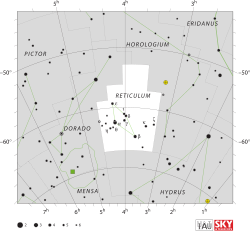
| |
| Observation data Epoch J2000.0 Equinox J2000.0 (ICRS) | |
|---|---|
| Constellation | Reticulum |
| Right ascension | 04 21 53.32714 |
| Declination | −63° 23′ 11.0072″ |
| Apparent magnitude (V) | 5.22 |
| Characteristics | |
| Spectral type | G7 III |
| U−B color index | +0.62 |
| B−V color index | +0.945 |
| Astrometry | |
| Radial velocity (Rv) | +45.0±0.8 km/s |
| Proper motion (μ) | RA: +85.56 mas/yr Dec.: +174.62 mas/yr |
| Parallax (π) | 8.48 ± 0.18 mas |
| Distance | 385 ± 8 ly (118 ± 3 pc) |
| Absolute magnitude (MV) | +1.28 |
| Details | |
| Mass | 2.54 M☉ |
| Radius | 12 R☉ |
| Luminosity | 120 L☉ |
| Surface gravity (log g) | 2.49 cgs |
| Temperature | 4,951±48 K |
| Metallicity | −0.15±0.03 dex |
| Age | 1.17 Gyr |
| Other designations | |
| Eta Ret, η Ret, CPD−63 324, FK5 163, HD 28093, HIP 20384, HR 1395, SAO 249009 | |
| Database references | |
| SIMBAD | data |
Eta Reticuli, Latinized from η Reticuli, is a solitary star in the southern constellation of Reticulum. With an apparent visual magnitude of 5.22, it is faintly visible to the naked eye on a dark night. Based upon an annual parallax shift of 8.48 mas, it is located at a distance of roughly 385 light years from the Sun. It may be a member of the high-velocity Zeta Herculis Moving Group of stars that share a common motion through space.
This is an evolved G-type giant star with a stellar classification of G7 III. Based upon stellar models, it has an estimated 2.54 times the mass of the Sun and 13.24 times the Sun's radius. With an age of around 1.17 billion years, it is radiating 120 times the solar luminosity from its outer atmosphere at an effective temperature of 4,948 K.
Eta Reticuli is moving through the Galaxy at a speed of 117.6 km/s relative to the Sun. Its projected Galactic orbit carries it between 11,700 and 31,600 light years from the center of the Galaxy.
References
- ^ van Leeuwen, F. (2007), "Validation of the new Hipparcos reduction", Astronomy and Astrophysics, 474 (2): 653–664, arXiv:0708.1752, Bibcode:2007A&A...474..653V, doi:10.1051/0004-6361:20078357, S2CID 18759600.
- ^ Mermilliod, J.-C. (1986), "Compilation of Eggen's UBV data, transformed to UBV (unpublished)", Catalogue of Eggen's UBV Data, Bibcode:1986EgUBV........0M.
- ^ Houk, Nancy; Cowley, A. P. (1979), Michigan catalogue of two-dimensional spectral types for the HD stars, vol. 1, Ann Arbor, Michigan: Dept. of Astronomy, University of Michigan, Bibcode:1978mcts.book.....H.
- de Bruijne, J. H. J.; Eilers, A.-C. (October 2012), "Radial velocities for the HIPPARCOS-Gaia Hundred-Thousand-Proper-Motion project", Astronomy & Astrophysics, 546: 14, arXiv:1208.3048, Bibcode:2012A&A...546A..61D, doi:10.1051/0004-6361/201219219, S2CID 59451347, A61.
- ^ Eggen, O. J. (1958), "Stellar groups. II. The ζ Herculis, ɛ Indi and 61 Cygni groups of high-velocity stars", Monthly Notices of the Royal Astronomical Society, 118 (2): 154, Bibcode:1958MNRAS.118..154E, doi:10.1093/mnras/118.2.154.
- ^ Luck, R. Earle (September 2015), "Abundances in the Local Region. I. G and K Giants", The Astronomical Journal, 150 (3): 23, arXiv:1507.01466, Bibcode:2015AJ....150...88L, doi:10.1088/0004-6256/150/3/88, S2CID 118505114, 88.
- ^ Pasinetti Fracassini, L. E.; et al. (2001), "Catalogue of Apparent Diameters and Absolute Radii of Stars (CADARS)", Astronomy & Astrophysics, 367 (2) (3rd ed.): 521–24, arXiv:astro-ph/0012289, Bibcode:2001A&A...367..521P, doi:10.1051/0004-6361:20000451, S2CID 425754.
- Alves, S.; et al. (April 2015), "Determination of the spectroscopic stellar parameters for 257 field giant stars", Monthly Notices of the Royal Astronomical Society, 448 (3): 2749–2765, arXiv:1503.02556, Bibcode:2015MNRAS.448.2749A, doi:10.1093/mnras/stv189.
- "eta Ret". SIMBAD. Centre de données astronomiques de Strasbourg. Retrieved 2017-02-15.
{{cite web}}: CS1 maint: postscript (link) - Eggleton, P. P.; Tokovinin, A. A. (September 2008), "A catalogue of multiplicity among bright stellar systems", Monthly Notices of the Royal Astronomical Society, 389 (2): 869–879, arXiv:0806.2878, Bibcode:2008MNRAS.389..869E, doi:10.1111/j.1365-2966.2008.13596.x, S2CID 14878976.
- "Eta Reticuli (HIP 20384)". Archived from the original on 2014-05-04. Retrieved 2012-08-17.
| Constellation of Reticulum | |||||||||||
|---|---|---|---|---|---|---|---|---|---|---|---|
| Stars |
| ||||||||||
| |||||||||||
| Galaxies |
| ||||||||||
| |||||||||||